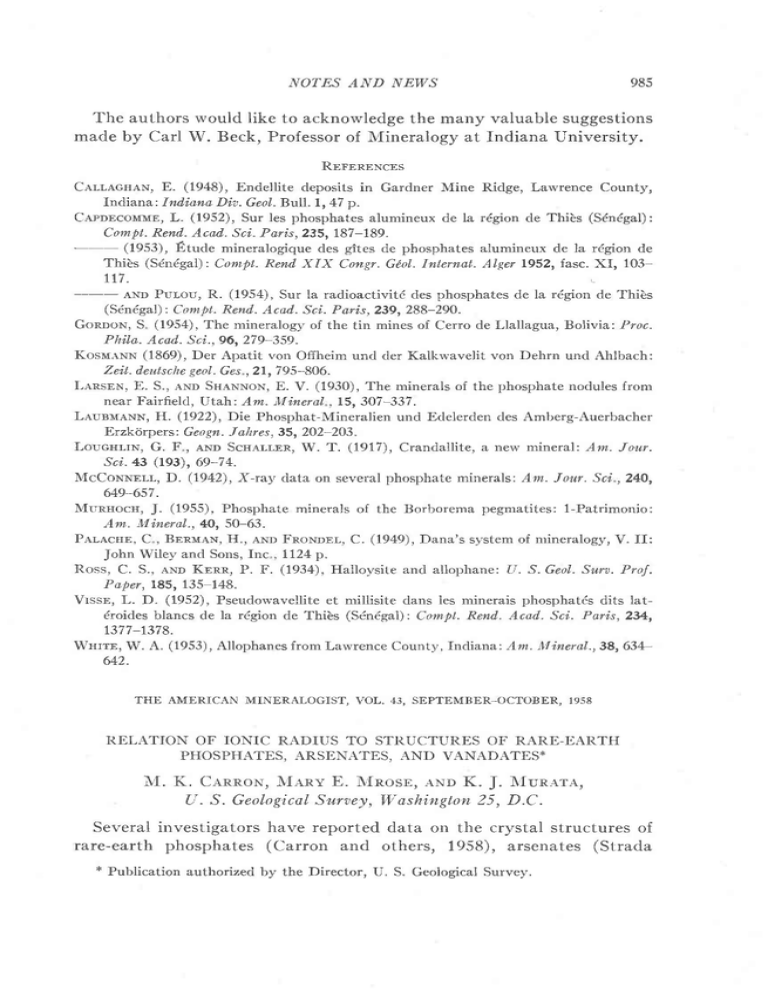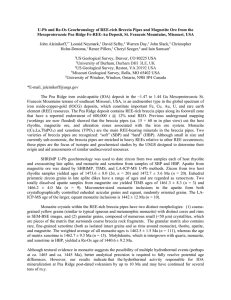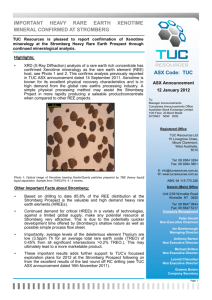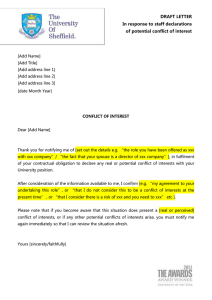The authors would like to acknowledge the many valuable
advertisement

NOTES AND NEWS
985
The authors would like to acknowledgethe many valuable suggestions
made by Carl W. Beck, Professorof Mineralogy at Indiana University.
RrrrnrNcrs
Car.l.a.cuau, E. (1948), Endellite deposits in Gardner Mine Ridge, Lawrence County,
I n d i a n a : I n d , i a n aD i . t . G e o L B d l . l r 4 7 p .
Ca.rorcouur, L. (1952), Sur les phosphates alumineux de la r6gion de Thibs (Sdn6gal):
Compt. Rend. Aca.d..Sci. Paris,235,187-189.
(19.53), Etude mineralogique des gites de phosphates alumineux de la rigion de
Thids (Sdn6ga1):Com.pt.Rend,XIX Congr. G1oL Internat. Alger 1952, fasc. XI, 103117.
---AND Pur,ou, R. (1954), Sur la radioactiviti des phosphates de la rdgion de Thibs
(Sdn6gal): Compt. Rend..Acad. Sci. Pari;,239,288-290.
GonooN, S (1954), The mineralogl' of the tin mines of Cerro de Llallagua, Rolivia: Proc.
P lila. A cad. Sei., 96, 279-359.
KosueNn (1869), Der Apatit von Ofiheim und der Kaikwavelit von Dehrn und Ahlbach:
Zeit. deutschegeol.Ges ,21,795-806.
Lansr'N. E. S., aNn SHaNNoN,E. V. (1930), The minerals of the phosphate nodules from
near Fairfield, Utah: Am. ll[ineral , 15, 307-337.
Launrt.r.Nx, H. (1922), Die Phosphat-Mineralien und Edelerden des Arnberg-Auerbacher
Erzkcirpers : Geogn. f alu es, 35, 2O2-2O3.
Lcrucur.rN, G. F , ano Scnar.lnn, W. T. (1917), Crandallite, a new mineral: Am. f our.
Sci.43 (r93), 69-74.
McCoNNnr.r., D.6942), X-ral' d21u on several phosphate minerals: Am. Jour.]ci,240,
649-657.
Mtinnocr, J. (1955), Phosphate minerals of the Borborema pegmatites: 1-Patrimonio:
Am. Mineral., 40, 50-63.
Par-acnn, C , Benrax, H., nno FnoNlr:r,, C. (1949), Dana's system of mineralogy, V. II:
John Wilei' and Sons, Inc . 1124 p.
Ross, C. S., aNn Krnn, P. F. (1934), Hallol,site and allophane: U. S.Geol. Sunt. ProJ.
Paper, 185,135 148.
Vrssn, L. D. (1952), Pseudowavellite et millisite dans les minerais phosphatds dits lat6roides blancs de la rigion de Thibs (S6n6ga1):Compt. Rend. Acod.. Sci. Paris, 234,
t377-r378.
W u r r n , W . A . ( 1 9 5 3 ) ,A l l o p h a n e s f r o m L a w r e n c eC o u n t y , f n d i a n a : A m . I f i n e r a l . , 3 8 , 6 3 4 642.
THU AMERICAN
MINERALOGIST,
VOL. 43, SEPTEMBER_OCTOBER, 1958
I{ELATION OF IONIC RADIUS TO STI{UCTURES
OF RARE-I'AI{TH
PHOSPHATES,
ARSENATES,
AND VANADATES*
l{. K. C-Lnnow,Xleny E. X,{nosn,ANDK. J. lIunrr.L,
U. S. Geological
Survey, Washinglon25, D.C.
Severalinvestigatorshave reported data on the crystal structures of
r a r e - e a r t h p h o s p h a t e s( C a r r o n a n d o t h e r s , 1 9 5 8 ) , a r s e n a t e s( S t r a d a
* Publication authorized by the Director, U. S. Geological Survey.
NOTES AND NEWS
and Schwendimann, 1934; Durif and Forrat, 1957), and vanadates
(Milligan, Watt, and Rachford, 1949; Durif, 1956). For each of these
groups of compounds, the boundary between the xenotime structure
(zircon type, tetragonal) and other structural types is at a difierent
element of the rare-earth group. Most of the investigatorsfailed to note
that the rare-earthelementswhich formed compoundsother than of the
xenotime type invariably produced compoundsisostructural with monazite (monoclinic).
The purpose of this work is to assemblethe available data and to
correlate crystal structures of the rare-earth compoundswith the ionic
radii of the trivalent elementsand the anions.
By wet chemical methods, we have produced rare-earth phosphates,
arsenates,and vanadates that were found by x-ray powder diffraction
patterns to be isostructural either with monazite or xenotime. In the
arsenatesystem,we confirmedthe study by Durif and Forrat (1957)who
showed SmAsO+ to be of the xenotime structure. They stated that
NdAsO+had a different structure which, however,they did not identify.
We found NdAsOa to be isostructural with monazite. In the vanadate
system we also confirmed the work of Milligan, Watt, and Rachford
(1949)who producedtheir compoundsbyigniting equimolecularmixtures
of the rare-earth oxides and ammonium metavanadate and reported the
vanadates of praseodymium through lutetium to be of the xenotime
structure. Durif (1956) reported that CeVOa,prepared by oxidation of
"CeVO3", had the xenotime structure. We also prepared CeVOr by adding a solution of ammonium metavanadate to a solution of cerouschloride and digestingthe soiution overnight on a steambath. The compound,
dried at 100oC., was found to be isostructuralwithxenotime. Neither of
the investigators cited above noted that only LaVOa has the monazite
structure. Carron and others (1958) have shown that in the phosphate
system TbPO4 (Tb3+:0.93 A) has the x-enotimestructure whereasits
precedingneighbor GdPO4 (Gd3+:0.97 A) has the monazite structure.
Among the actinides,PuPOa(Put+:1.08 A) has been shown to have the
monazite structure (Bjorklund, 1957). With regard to scandium, we
found that ScPOa,preparedin a bomb at. 300oC. from solutionsof ScCla
and dilute phosphoricacid, and ScVOa,prepared by igniting ScsOaand
VzOs at 1000" C., has the xenotime structure. We also prepared a hydrated scandium arsenatefrom solutionsof ScCIsand dilute arsenicacid
which was isostructural with the metavariscite group of minerals. On
ignition this compoundassumedthe xenotime structure.
Table 1 is a compilation of all of the anhydrousrare-earthphosphates'
arsenates,and vanadates, showing the limiting elements for the monazite and xenotime structures in each system. It shows that the xenotime
NOTES AND NEWS
987
NtA7l
x,tx
XXX
ts
XXX
z
o
z
XXX
14
F
z
XXX
ts
XXX
ts
XXX
E
z
XXX
Fr
O
a
,4
t
X
ts
a
X
.9.
E
H
O
X
EH
z
X
ts
x
|j
9.t
JN
E9e
F
F . EE
+lX
O
FOX
E
tl
.<,;
.9 ; fl-
<'!
N
EE>
:d
0i<
I
988
NOTDS AND NEWS
structure can accommodateincreasinglylarger cations as the size of the
anion increases.There is a quantitative relationship between the radius
of the largest xenotime-formingrare-earth element and the size of the
anion, in the following manner (formal sixfold coordination radii from
Ahrens, 7952):
'
P-O
As-O
V-O
A:Oxygen-central
atomdistance,
A
1.7S
1.86
l.gg
B:Radius oI thelargestrare-earth
element
formingthexenotime
structure,
A
.Olitt r*; 1.00(Smr+; 1.07(Cga+;
A/B
1.88
1.86
1.86
The A/B ratio of 1.86 seemsto specify the size limits of both the cation
and anion at the xenotime-monazitestructural boundary. This ratio
would lead to the prediction that among orthosilicatecompounds(formal
Si-O distanceof 1.82A; tne largestcation radius permissiblefor the xenotime structure would be 0.98 A. this predictedradius is very closeto that
of quadrivalent uranium (0.97 A), and USiOa,coffinite, with the xenotime structure has beensynthesizedrecently (Hoekstra and Fuchs, 1956).
Quadrivalent thorium (1.02 A) which is only 0.04 A la.get than the predicted size forms an orthosilicatewith either the monazite or xenotime
structure.
fsomorphous substitution of the anions among the rare-earth phosphate, silicate, arsenate,and vanadate systems seems to be possible.
However, analysesof xenotime and monazite reported in the literature
(Palache and others, 1951) indicate possiblereplacement of only SiOa
for POa.Although there are no known rare-earth arsenateor vanadate
minerals,it might be well in future analysesof rare-earthphosphatesand
silicatesto test for the possiblepresenceof small amounts of arsenicand
vanadium.
The authors wish to expressthanks to Harry Rose,Jr., for numerous
helpful commentsand discussions.
RerrnnNcBs
AunnNs, L H. (1952), The use of ionization potentials. Part 1. Ionic radii of the elements:
Geochim.et Cosmochim.Acta,2, 155-169.
B;onxr.uNo, C. W. (1957), The preparation of PurPzOzand PuPOr: Am. Chetn. Soc.Jour.,
79, 6347-6350.
ClnnoN, M. K , N,msnn, C. R., Rosn, H. J., Jn., er-'n HrlonnllNo, F. A (1958), l'ractional precipitation of rare earths n'ith phosphoric acid: L/. S. GeoI. Surt:ey Bull.
1036-N, 253 .275.
D u n r r , A . ( 1 9 5 6 ) ,S t r u c t u r e e t v a l e n c e sd e V C e O r : A c t a C r y t s t . , 9 ,p , 4 7 1 .
Dunrr', A., axn Fonnar, F. (1957), Sur quelques ars6niates des terres rares i, structure
zircon: Acad. Sci. Paris Comptes Rendus,245, 1636-1638.
Honxsrne, H. R., eNt Fucrs, L. H. (1956), Synthesis of coffinite-USiOe:,Science, 123,
105.
NOTES AND
989
NEWS
I{tr.r.rcer+, W. G., Werr, L. M., lr,l Racruono, H. J., Jn. (1949). X-ray diffraction studies
on heavy metal orthovanadates: f our. Plrys. and.Colloid,Chem.-,53,No. 2, 227-234.
P.tr.acnn, C , Benuax, H-, antl Fnomonr., C. (19.51),Dana's System of Nlineralogy, 7th
ed.,2, 690,694, Neu' York, John Wiley and Sons,Inc.
Srnana, M., .rNo ScHwnNorlrlnN, G. (1934), 'Ihe crystalline structure of some phosphates
and arsenatesof trivalent rnetals. II. Yttrium arsenate and yttrium phosphate: Gazz.
cld.m.itoli.ana,64, 662474 (in Italian)
TFIE AMERICAN MIN]'RALOGIST,VOL. 43, SEPTEMBER_OCTOBER,
19.58
GOETHITE-HEMATITE
RELATION-AN
N{ICROSCOPE OBSERVATION
ORE
l,{rurn Kuuen Bosn,
Geologi cal L aboral,or y, P r esidencyCollege, Calcutta, I nd.ia.
To the south of Chaibasa(22"33':85'28'), Singhbhum,India, near the
northern limit of the Kolhan basin, the fracture zonesformed by postKolhan deformation,have beenmineralizedby a metalizingsolution.The
mineralizationis more common in the competent sandstonethan in the
shale, and also along the sandstone-shaleboundary. The mineralizing
solution was ferriferous in the first phase and formed such minerals as
limonite, goethite and sp€:cularite,
thesebeing followed by a phaseof formation of the manganeseminerals psilomelane,pyrolusite, and its idiomorphic form. The important textural relations are the core and rim
replacementof goethite by psilomelane,and an intergrowth relation between fibrous goethite and hematite. The latter texture is describedin
this note.
Such a specimen of goethite on analysis shows a higher content of
FezOs(91.37a),than normal, becauseof the included hematite plates.*
The intergrowth has been studied on different polished surfaceswith
respect to the fibre axis. Goethite, the host mineral under reflecting
microscope is greyish with perceptible differential adsorption in some
specimens,being brighter parallel to the fibre axis. Unusual for goethite,
the bireflectanceis very weak but with the commoner orange internal
reflection.Thesepropertiesare variable sincethey dependon the content
of adsorbed water (Ramdohr 1955). The mineral is stained brown by
Snclz (1i minute). The reflectancemeasured in green light in air is
19.37aparallelto the fibre axis and 17.5o/o
across.Specimenspolishedperpendicular to fibre axis shows no notable variation in reflecting power.
Hematite inclusions occur as continuous plates within the host. In
* The planes of hematitization are
actually micro S-planesproduced by a post-Kolhan
rleformation, the pattern of which is being studied in this laboratory.



